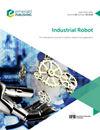Augmented reality-assisted gesture-based teleoperated system for robot motion planning
IF 2.5
4区 计算机科学
Q3 ENGINEERING, INDUSTRIAL
Industrial Robot-The International Journal of Robotics Research and Application
Pub Date : 2023-02-02
DOI:10.1108/ir-11-2022-0289
引用次数: 1
Abstract
Purpose The study proposed a human–robot interaction (HRI) framework to enable operators to communicate remotely with robots in a simple and intuitive way. The study focused on the situation when operators with no programming skills have to accomplish teleoperated tasks dealing with randomly localized different-sized objects in an unstructured environment. The purpose of this study is to reduce stress on operators, increase accuracy and reduce the time of task accomplishment. The special application of the proposed system is in the radioactive isotope production factories. The following approach combined the reactivity of the operator’s direct control with the powerful tools of vision-based object classification and localization. Design/methodology/approach Perceptive real-time gesture control predicated on a Kinect sensor is formulated by information fusion between human intuitiveness and an augmented reality-based vision algorithm. Objects are localized using a developed feature-based vision algorithm, where the homography is estimated and Perspective-n-Point problem is solved. The 3D object position and orientation are stored in the robot end-effector memory for the last mission adjusting and waiting for a gesture control signal to autonomously pick/place an object. Object classification process is done using a one-shot Siamese neural network (NN) to train a proposed deep NN; other well-known models are also used in a comparison. The system was contextualized in one of the nuclear industry applications: radioactive isotope production and its validation were performed through a user study where 10 participants of different backgrounds are involved. Findings The system was contextualized in one of the nuclear industry applications: radioactive isotope production and its validation were performed through a user study where 10 participants of different backgrounds are involved. The results revealed the effectiveness of the proposed teleoperation system and demonstrate its potential for use by robotics non-experienced users to effectively accomplish remote robot tasks. Social implications The proposed system reduces risk and increases level of safety when applied in hazardous environment such as the nuclear one. Originality/value The contribution and uniqueness of the presented study are represented in the development of a well-integrated HRI system that can tackle the four aforementioned circumstances in an effective and user-friendly way. High operator–robot reactivity is kept by using the direct control method, while a lot of cognitive stress is removed using elective/flapped autonomous mode to manipulate randomly localized different configuration objects. This necessitates building an effective deep learning algorithm (in comparison to well-known methods) to recognize objects in different conditions: illumination levels, shadows and different postures.基于增强现实辅助手势的机器人运动规划遥操作系统
目的提出一种人机交互(HRI)框架,使操作者能够以简单直观的方式与机器人进行远程通信。该研究的重点是在非结构化环境中,没有编程技能的操作员必须完成远程操作任务,处理随机定位的不同大小的物体。本研究的目的是为了减轻操作员的压力,提高准确性,缩短任务完成时间。该系统的特殊应用是在放射性同位素生产工厂。下面的方法将操作员直接控制的反应性与基于视觉的目标分类和定位的强大工具相结合。设计/方法/方法基于Kinect传感器的感知实时手势控制是通过人类直觉和基于增强现实的视觉算法之间的信息融合而制定的。使用开发的基于特征的视觉算法对目标进行定位,其中估计了单应性并解决了视角-n点问题。三维物体的位置和方向存储在机器人末端执行器存储器中,用于最后一次任务的调整和等待手势控制信号来自主拾取/放置物体。目标分类过程使用单次暹罗神经网络(NN)来训练所提出的深度神经网络;在比较中还使用了其他知名模型。该系统在一个核工业应用中进行了背景化:放射性同位素生产及其验证通过用户研究进行,其中涉及10名不同背景的参与者。该系统在一个核工业应用中进行了背景化:放射性同位素生产及其验证通过一个用户研究进行,其中涉及10名不同背景的参与者。结果揭示了所提出的远程操作系统的有效性,并展示了它的潜力,用于机器人技术的非经验用户有效地完成远程机器人任务。社会意义当应用于危险环境(如核环境)时,提议的系统降低了风险并提高了安全水平。原创性/价值本研究的贡献和独特性体现在开发了一个集成良好的人力资源调查系统,该系统可以以有效和用户友好的方式处理上述四种情况。采用直接控制方式保持操作者-机器人的高反应性,同时采用选择性/扑动自主方式对随机定位的不同构型物体进行操作,消除了操作者的认知压力。这就需要建立一个有效的深度学习算法(与众所周知的方法相比)来识别不同条件下的物体:光照水平、阴影和不同的姿势。
本文章由计算机程序翻译,如有差异,请以英文原文为准。
求助全文
约1分钟内获得全文
求助全文
来源期刊
CiteScore
4.50
自引率
16.70%
发文量
86
审稿时长
5.7 months
期刊介绍:
Industrial Robot publishes peer reviewed research articles, technology reviews and specially commissioned case studies. Each issue includes high quality content covering all aspects of robotic technology, and reflecting the most interesting and strategically important research and development activities from around the world.
The journal’s policy of not publishing work that has only been tested in simulation means that only the very best and most practical research articles are included. This ensures that the material that is published has real relevance and value for commercial manufacturing and research organizations. Industrial Robot''s coverage includes, but is not restricted to:
Automatic assembly
Flexible manufacturing
Programming optimisation
Simulation and offline programming
Service robots
Autonomous robots
Swarm intelligence
Humanoid robots
Prosthetics and exoskeletons
Machine intelligence
Military robots
Underwater and aerial robots
Cooperative robots
Flexible grippers and tactile sensing
Robot vision
Teleoperation
Mobile robots
Search and rescue robots
Robot welding
Collision avoidance
Robotic machining
Surgical robots
Call for Papers 2020
AI for Autonomous Unmanned Systems
Agricultural Robot
Brain-Computer Interfaces for Human-Robot Interaction
Cooperative Robots
Robots for Environmental Monitoring
Rehabilitation Robots
Wearable Robotics/Exoskeletons.

 求助内容:
求助内容: 应助结果提醒方式:
应助结果提醒方式:


